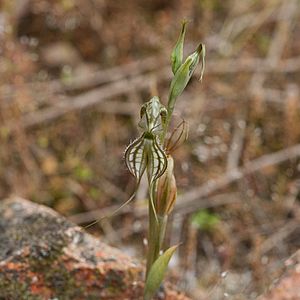Bristled rustyhood facts for kids
Quick facts for kids Bristled rustyhood |
|
|---|---|
 |
|
| Pterostylis biseta growing near Keith | |
| Scientific classification | |
| Genus: |
Pterostylis
|
| Species: |
biseta
|
| Synonyms | |
|
|
The bristled rustyhood, also known as Pterostylis biseta, is a special type of plant. It belongs to the amazing orchid family. This unique orchid grows only in south-eastern Australia. It has a group of leaves at its base, shaped like a flower. It can grow up to seven large, see-through flowers. These flowers have cool green and brown patterns. They also have a brown or green part that looks like an insect. This part is called the labellum and it has tiny bristly hairs. You can find this orchid in New South Wales, South Australia, and Victoria. Scientists are still studying this plant, especially in Victoria and New South Wales.
Contents
What is the Bristled Rustyhood?
The bristled rustyhood is a perennial plant. This means it lives for more than two years. It is also a deciduous herb. This means it loses its leaves at certain times of the year. It grows from a special underground part called a tuber. At the bottom of its flowering stem, it has a rosette of six to fourteen leaves. Each leaf is about 15 to 40 mm long and 8 to 12 mm wide. Often, these leaves dry up by the time the flowers bloom.
What Does it Look Like?
The bristled rustyhood can have up to seven flowers. These flowers are a beautiful translucent green and brown. They are quite large, about 50 to 58 mm long and 12 to 14 mm wide. The whole flowering stem can grow to be 100 to 350 mm tall. The stem has two to six thin, papery leaves called bracts wrapped around it.
The top part of the flower, called the "galea," forms a hood. This hood covers the central part of the flower. The top part of the galea has a thin, thread-like tip. This tip is about 11 to 15 mm long. The side parts of the flower are wider than the hood. They are shaped like a dish and have many hairs on their outer edges. These side parts also end in a thin, thread-like tip. These tips are about 25 to 35 mm long.
The most interesting part is the labellum. It is brown to green and looks like a thin insect. It is about 6 to 8 mm long and 4 mm wide. The "head" end of this insect-like part is swollen. It has two long bristles, like antennae. There are also up to 34 shorter bristles along its sides. This orchid usually flowers from September to November.
How Was it Named?
The bristled rustyhood was first officially described in 1968. Two scientists, John Blackmore and Stephen Clemesha, gave it its scientific name. They found a sample of the plant near Blackwood. The name biseta comes from two Latin words. The word bi- means "two," and seta means "bristle." This name perfectly describes the two long bristles on its labellum!
Scientists are still studying this species. For example, in Victoria, some scientists have divided it into three different species. These are Pterostylis despectans, P. planulata, and P. sp. aff. biseta (Pink Lakes). In New South Wales, they are also looking closely at its classification.
Where Does it Grow?
The bristled rustyhood, as we know it now, grows in a few places. In New South Wales, you can find it south of Hillston. It also grows in northern Victoria and in the south-east of South Australia. This orchid likes to grow in thin forests. You might often see it on rocky hills. It also lives in dry, scrubby areas.

